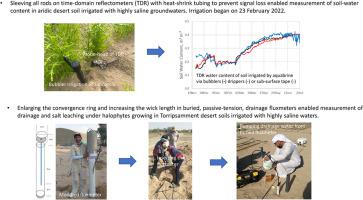Journal of Arid Environments ( IF 2.7 ) Pub Date : 2023-12-07 , DOI: 10.1016/j.jaridenv.2023.105115 Mansoor Al-Tamimi , Steve Green , Wasel Abou Dahr , Ahmed Al-Muaini , Dionysia Lyra , Khalil Ammar , Mohamed Dawoud , Paul Kenyon , Peter Kemp , Lesley Kennedy , Brent Clothier

|
There is a need to understand the link between the impacts on groundwater and the benefits when using saline waters to irrigate halophytes growing on Torripsamment desert soils in hyper-arid environments. We set up a pilot trial near Dubai using irrigation with highly saline waters with electrical conductivities (EC) between 25 and 40 dS m−1. Two difficulties were encountered. One related to our inability to measure the soil's water content. Our three-wire time domain reflectometer (TDR) probes could not measure the water content because of the high electrical conductivity. But by shielding all three wires of the TDR probe with glue-lined heat-shrink we found that Topp's TDR equation applied, and we could measure the rise in water content during the daily irrigations. Initially our passive-tension drainage fluxmeters (DFM) did not register drainage at a depth of 600 mm. We considered the failure of the DFMs was due to the disturbance of the calcic and gypsic materials at depth, such that when the re-packed soil was s re-wet it formed an impermeable layer. We installed the top of the DFMs at a depth of 200 mm. We increased the diameter of the convergence ring from 150 mm to 250 mm for wider drainage capture and increased the wick length of the passive tension from 600 mm to 700 mm. Our measurements showed the DFMs found that the EC of the leachate could reach over two times that of the applied irrigation water.
中文翻译:

测量超干旱环境中用微咸水灌溉盐生作物对地下水盐度影响的装置
当使用咸水灌溉在极度干旱环境中的Torripsamment 沙漠土壤上生长的盐生植物时,需要了解对地下水的影响和效益之间的联系。我们在迪拜附近进行了一项试点试验,使用电导率 (EC) 在 25 至 40 dS m −1之间的高盐度水进行灌溉。遇到了两个困难。其中之一与我们无法测量土壤的含水量有关。由于电导率较高,我们的三线时域反射计 (TDR) 探头无法测量水含量。但通过用胶水热缩管屏蔽 TDR 探头的所有三根电线,我们发现 Topp 的 TDR 方程适用,并且我们可以测量日常灌溉期间水分含量的上升。最初,我们的被动张力排水通量计 (DFM) 没有记录 600 毫米深度的排水情况。我们认为 DFM 的失效是由于深度处钙质和石膏材料的扰动,使得当重新填充的土壤重新湿润时,它形成了不渗透层。我们将 DFM 的顶部安装在 200 毫米的深度。我们将会聚环的直径从 150 毫米增加到 250 毫米,以实现更广泛的排水捕获,并将被动张力的灯芯长度从 600 毫米增加到 700 毫米。我们的测量结果表明,DFM 发现渗滤液的 EC 可以达到灌溉水的两倍以上。



























 京公网安备 11010802027423号
京公网安备 11010802027423号